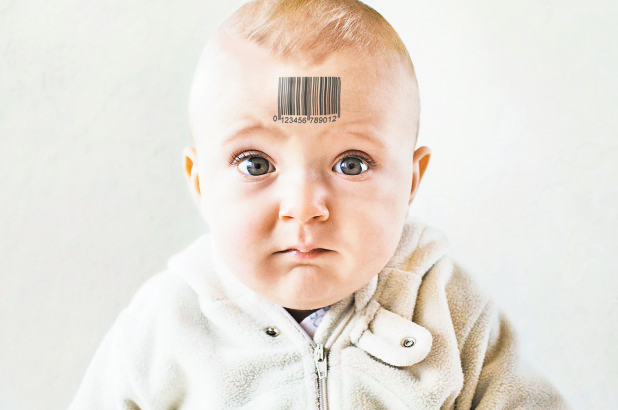Similar to flying cars and memory-erasing neuralyzers, genetically-modified babies might originally sound like something straight out of a futuristic sci-fi film. However, with the rapid advancements of technology in the twenty-first century, “designer babies,” or babies who have been genetically engineered “in vitro” for specially selected characteristics, are already here. In late 2018, a Chinese scientist, He Jiankui, announced the birth of twin girls, Lulu and Nana, whose DNA he claims to have modified using the gene-editing technique CRISPR to give the baby girls HIV resistance, a trait fewer than 1% of people are estimated to have.1 Since Jiankui’s introduction of his designer baby girls into the media, concerns have been raised regarding the ethics of the unusual practice. Designer babies have become an important subject in bioethical debates and questions have been raised about implementing limitations regarding designer babies in the future.
“In vitro fertilization,” or IVF, is a process in which fertilization of the egg takes place outside of the woman’s body. The participant’s ovulatory process is stimulated and monitored, and, when the time is right, an ova or ovum, or the egg, is extracted from the ovaries and fertilized with sperm in a laboratory. The zygote, or fertilized egg, then undergoes embryo culture for two to six days. After this period of time, the zygote is implanted into the participant’s uterus, where it is free to develop and grow as a normal fetus. IVF is usually only frequented by parents who are at risk of having a child with a genetic disease, such as carriers of a monogenic diseases or of chromosomal structural aberrations, or, alternatively, by parents who suffer concurrent infertility or recurrent miscarriages. Preimplantation genetic testing is typically conducted after in vitro fertilization, and involves checking the embryo for any genetic defects. This process is formally called “preimplantation genetic diagnosis.” Only the embryos that are free of defects are finally replaced into the womb.2 IVF in the U.S. averages around $1o,ooo to $15,000, not including additional costs such as medication, genetic testing, etc.3
Though a fairly new subject, the concept of designer babies has been around longer than one would think. One early case of human genetic manipulation took place in 1996, over twenty years ago, when Scott and Monique Collin visited the Genetics & IVF Institute in Fairvax, Virginia. The couple, after the birth of their two sons, wanted to ensure that their third child was a girl, and found the answer to their problem in in vitro fertilization. The team of researchers at the Genetics & IVF Institute, adapting a technique used on livestock, took advantage of a basic rule in biology: girls have two X chromosomes, while boys have one X and one Y chromosome. Because mothers only have two X chromosomes, it’s in the father hands, or rather in the father’s sperm, to bring either an X or Y chromosome to the table, determining the baby’s sex. However, Y chromosomes occur less frequently than X chromosomes. The doctors used this to their advantage and used a light-sensitive nontoxic dye to stain the sperm’s DNA, organizing the sperm by gender before a successful artificial insemination. Prior to the Collins’ case, in vitro fertilization was performed only to address certain medical conditions or diseases.

The Collins’ designer baby procedure entered the public vernacular when they were featured in Time Magazine’s 1999 article, “Designer Babies.” The procedure was met with both praise and criticism. Dr. Zev Rosenwaks, director of the Center for Reproductive Medicine and Infertility at Cornell Medical Center in New York City, responded, “Our view at the moment is that these techniques should be used for medical indications, not family balancing.” Biotechnology critic Jeremy Rifkin, appalled by the concept, added, “It’s the ultimate shopping experience: designing your baby. In a society used to cosmetic surgery and psychopharmacology, this is not a big step.4
CRISPR (pronounced “crisper”) is shorthand for CRISPR-Cas9. CRISPR technology is a powerful tool used by researchers to easily alter DNA sequences and modify gene functions. It allows for the correction of genetic defects, preventing the spread of diseases, and aids in the improvement of crops. CRISPRs are strands of DNA—the protein Cas9 is an enzyme capable of acting as a pair of molecular scissors, one that can accurately cut strands of DNA. Although already fairly powerful, this technology was further adapted by the natural defense mechanisms of bacteria and archaea. These microorganisms use CRISPR-derived DNA and Cas9 protein to prevent attacks from viruses, which they do by cutting up and destroying the DNA of an invader. When these components are transferred to a more complex organisms, it allows for the manipulation, or editing, of genes.5 CRISPR-Cas9 allows the ability to “edit” the DNA sequence of a defective gene by deleting or inserting bases at the zygote stage of embryonic development, potentially ridding not only that person, but also their progeny, of a particular genetic disease.6
Although the use of CRISPR technology to modify embryos, eggs, or sperm is banned in the United States, it is permitted in China. In November 2018, Chinese scientist He Jiankui modified the embryos of seven couples, all of which the males had HIV, during in vitro fertilization. His goal was to remove the pathway through which HIV enters the body by ordering CRISPR-Cas9 to disable a gene called CCR₅, thereby giving the babies HIV resistance. From this procedure came the aforementioned twin girls under the pseudonyms Lulu and Nana.7 Surely this was an accomplishment for Jiankui, but his experiment raised questions and concerns within the science community. Some felt that, when using this technology, there was always the risk of genetically altering genes that weren’t supposed to be modified. Many also emphasized the fact that people with deficiencies in CCR₅ are more susceptible to West Nile Virus and Japanese encephalitis. However, when met with backlash over his controversial project, Jiankui replied, “I understand that my work will be controversial, but I believe families need this technology, and I’m willing to take the criticism for them.”8 Jiankui also spoke on the discrimination HIV-positive people face in China. Despite the backlash, not all people were critical of his project. George Church, a Harvard University geneticist, believes Jiankui’s work was justified, as HIV is a major and growing public health threat. “As long as these are normal, healthy kids, it’s going to be fine for the field and the family,” Church added.9

Jiankui’s project, along with every other case of genetic modification, received a lot of questions and concerns about whether or not it could be morally defended. Although Jiankui’s case only involved disabling CCR₅ and the Collins’ case only involved the selection of gender, they raised issues such as using CRISPR for cosmetic means as well, like choosing eye color, hair color, or height, which many didn’t find morally ethical. The issue of a wider class gap in society was also raised. If genetic modification became a realistic and accessible medical practice, it would create great division between those who could afford a designer baby and those who couldn’t. People fear that the economic division will soon grow into genetic division, with social distinctions and picture-perfect features separating enhanced individuals from unenhanced individuals. The 1997 sci-fi film Gattaca explores this by depicting a society in which only genetically modified individuals, the “valids,” have a place in society’s upper class, whereas those conceived without the aid of genetic selection, the “in-valids,” do not. While these concerns and fears are very valid, the benefits of genetic modification well outweigh the risks.

In a country with already very distinct divisions in social status, the practice of genetic modification would do little to no damage on social class. Nobody wanted to prohibit the introduction of luxury cars or designer bags in America, though they are clearly very ostentatious displays of wealth. Despite the possibility of designer babies becoming just another possession the rich and wealthy can boast about, genetic modification becoming a regular practice in the medical field would only allow for growth in knowledge about genetic diseases. The Council on Ethical and Judicial Affairs released a statement in 1994 in support of using genetic modification to treat, cure, or prevent genetic diseases, but that selection based on benign characteristics is unethical.10 While genetically engineering children to fit into the mold of a “perfect” child is undeniably selfish and unscrupulous, using CRISPR technology for medical advancements is justifiable and defendable. As mentioned before, Jiankui only genetically modified the twin girls’ DNA to remove the pathway through which HIV enters in order to give them HIV resistance—something that wouldn’t have been possible had the children been conceived naturally. Bioethicists also argue that parents have a right to prenatal autonomy, which grants them the right to decide the fate of their children.11 Parents who have lived difficult and expensive lives due to disease should be able to ensure that the same terrible disease isn’t inherited by their offspring. Genetic engineering will give thousands of children the opportunity to live a long and happy life free of the burden of any genetic disease, such as AIDS, blood disorders, muscular dystrophy, and even cancer.12
In the case of modernizing CRISPR technology, the possibility of preventing or reducing the risk of genetic disease far outweighs its moral implications. Genetic engineering, if not used with superficial motives, has the potential to ensure the health of an entire population of children sick with inherited disease. An ethical point of view should not halt the advancements of technology and overall knowledge of biology.
- Carly Stern, “Meet the Chinese Researcher Behind the ‘World’s First Designer Babies,’” OZY (blog), November 28, 2018, https://www.ozy.com/need-to-know/meet-the-chinese-researcher-behind-the-worlds-first-designer-babies/90908. ↵
- Karen Sermon, “Preimplantation genetic diagnosis,” The Lancet 363, no. 9421 (2004): 23. ↵
- Rachel Gurevich, “How Much Does IVF Really Cost?,” VeryWellFamily (blog), March 20, 2019, https://www.verywellfamily.com/how-much-does-ivf-cost-1960212. ↵
- Michael Lemonick, “Designer Babies,” TIME magazine, January 11, 1999, http://content.time.com/time/magazine/article/0,9171,17696-1,00.html. ↵
- Aparna Vidyasagar, “What is CRISPR?,” Live Science, April 20, 2018, https://www.livescience.com/58790-crispr-explained.html. ↵
- Daryl F. Sas and Hannah M. Lawrenz, “CRISPR-Cas9: The Latest Fashion in Designer Babies,” Ethics and Medicine: An International Journal of Bioethics Vol. 33, no. 2 (2017): 81. ↵
- Carly Stern, “Meet the Chinese Researcher Behind the ‘World’s First Designer Babies,’” OZY, November 28, 2018, https://www.ozy.com/need-to-know/meet-the-chinese-researcher-behind-the-worlds-first-designer-babies/90908. ↵
- Carly Stern, “Meet the Chinese Researcher Behind the ‘World’s First Designer Babies,’” OZY (blog), November 28, 2018, https://www.ozy.com/need-to-know/meet-the-chinese-researcher-behind-the-worlds-first-designer-babies/90908. ↵
- Rachel Cocker, “Designer babies are not a health threat, says geneticist,” Daily Telegraph, March 16, 2019, https://www.pressreader.com/uk/the-daily-telegraph/20190316. ↵
- National Center for Biotechnology Information, 1994, s.v. “Ethical issues related to prenatal genetic testing. The Council on Ethical and Judicial Affairs, American Medical Association.” ↵
- National Center for Biotechnology Information, 2002, s.v. “Autonomy and freedom of choice in prenatal genetic diagnosis.” ↵
- Clara Rodriguez Fernandez, “Seven Diseases That CRISPR Technology Could Cure,” LABIOTECH (blog), June 25, 2018, https://labiotech.eu/tops/crispr-technology-cure-disease/. ↵



65 comments
Carlos Hinojosa
It’s a interesting topic and definitely controversial but I would say it’s necessary in some means while unnecessary in others. This idea of designing a baby destroys the idea that everyone would be unique because there could be a point in time where a whole generation of babies just follow a trend. Necessary part I would say is like deleting a genetic disease like cancer or Alzheimer’s from the family besides that I would consider it unethical.
Hoa Vo
I really like the name you brought for this article which caught my eyes at first because it would be a controversial topic. I totally agree with you that the benefit of this CRISPR technology in terms of designing babies is far more overweigh the unethical part. I do understand the reason why people think this is unethical, but I think it is a groundbreaking step for whoever wants to have a child born with the best sides of a human. Some people would say that just let the baby be born normally and teach them how beautiful they are but they should know that they are the ones who decide to have a baby, not the babies themselves, so basically the purposes are the same. Moreover, normally breeding also has a high chance of deformities but these technologies can minimize that. Overall, we still want the babies to be born in the best conditions so they can be comfortable and confident with their life, so it’s all service for our purpose.
Andrea Ramirez
What an interesting article! I had heard something about this topic some time ago, and they called it “baby à la carte”, but I really didn’t know if it was something real or fictitious. I really liked that you explained exactly what IVF and CRISPR technology are about, as well as the process, because that allowed me to understand the subject well. Also, I found the case of Scott and Monique Collin very intriguing, of how they used IVF to manipulate the gender of their third and future daughter (not to mention the case of Lulu and Nana). Especially around the time this happened. Lastly, I was not aware that this technique was mainly used for the correction of genetic defects, and the prevention of the spread of diseases. Well, this potentially frees not only that person, but also their offspring, from a genetic disease. So in this last case, I don’t see the use of this technology as wrong, but rather the opposite. On the other hand, I don’t know what to say in the case of the use of this technology to change the physical features of a future baby.
Caily Torres
After reading this article, I see the ethical dilemma of IVF but not that of CRISPR gene editing to make “designer babies”. The zygote which is placed in the mothers uterus after undergoing observation is free to develop as a normal fetus would. However, the other zygotes (since they fertilize more than one egg in the process) are killed. On the other hand, CRISPR is just a gene editing tool which allows us to alter the DNA sequence. If the ethical dilemma here is that people are using it to not only fix diseases but to alter physical appearance, then I don’t understand. It’s almost like choosing a sperm donor with certain characteristics, yeah there’s still a possibility that the child will not have those characteristics but I view it as the same. People find it unethical because not everyone can afford it, but as the article said, that didn’t stop us from bringing and purchasing luxury cars, bags, and clothes.
Trenton Boudreaux
I wasn’t aware that we had the technology for “Designer babies” already. I will admit that the ability to eliminate diseases that affect generational lines is a compelling one, but I also feel weird about this whole thing. Not just on the grounds of changing and customizing physical characteristics, but also on the grounds that this could provide justification for eugenicist groups to attack certain people for being unfit for life. I realize that it’s a bit of a stretch, but I feel it is still a legitimate concern especially when considering what counts as a disease.
Max van de Kuilen
This was a very interesting article and a very controversial topic. I understand your point of view, that using genetic modification as a medical asset could be very beneficial. However I think there should be very strict rules about the boundaries on genetic modification. In my opinion there should never be an option to alter a baby’s DNA outside of critical health reasons. And even then, it should be available for everyone, not just the ones who can afford it.
Thiffany Yeupell
I somewhat remember when Jiankui’s actions made it to the news and it definitely stirred up controversy. Although CRISPR should be used to help prevent the passing of troublesome genetic conditions and disease, it will most likely fall into the hands of profit and be used for the engineering of designer babies. I know that my thought process went to the unfair advantage people would have by having access to this tool due to wealth, but Mendez’s point of the possible genetic gap that distinguishes the upper from the lower classes as certain features will indicate status, as time goes on really, brought more questions and discussions for that point in my head.
Savannah Alcazar
I found this article to be interesting because my little cousin is basically a designer baby… I see both sides of being ethical and unethical. I think in vitro is good for those who have trouble conceiving on their own. That is the reason my aunt went through the process, however, they only chose female embryos.
I enjoyed the information in your article. The science is fascinating and seems very well researched. Good read.
Shea Slusser
I actually was a little surprised to see this topic as one an article because I recently almost did research on this topic and use it in a persuasive speech. I do believe that there are pros to the idea and that it could do society good to introduce it, however I also realize there is much debate that people with money to modify there babies might take advantage of this technology and use it for personal wants, not because the baby actually needs it to prevent disease or a disorder. Very interesting topic and would recommend the read.
Gabriella Urrutia
This article was very interesting to read and provided a lot of detail about the topic. I agree that if it were used to modify genes in order to get rid of disease, it would be good. But if it were just used to make children look a certain way, I would think that it isn’t a good thing. I believe that if it were used for the right thing, it could be very beneficial.